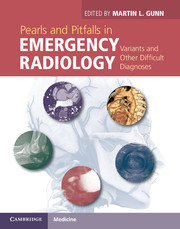Book contents
- Frontmatter
- Contents
- List of contributors
- Preface
- Acknowledgments
- Section 1 Brain, head, and neck
- Section 2 Spine
- Section 3 Thorax
- Section 4 Cardiovascular
- Section 5 Abdomen
- Section 6 Pelvis
- Section 7 Musculoskeletal
- Case 78 Pseudofracture from motion artifact
- Case 79 Mach effect
- Case 80 Foreign bodies not visible on radiographs
- Case 81 Accessory ossicles
- Case 82 Fat pad interpretation
- Case 83 Posterior shoulder dislocation
- Case 84 Easily missed fractures in thoracic trauma
- Case 85 Sesamoids and bipartite patella
- Case 86 Subtle knee fractures
- Case 87 Lateral condylar notch sign
- Case 88 Easily missed fractures of the foot and ankle
- Section 8 Pediatrics
- Index
- References
Case 78 - Pseudofracture from motion artifact
from Section 7 - Musculoskeletal
Published online by Cambridge University Press: 05 March 2013
- Frontmatter
- Contents
- List of contributors
- Preface
- Acknowledgments
- Section 1 Brain, head, and neck
- Section 2 Spine
- Section 3 Thorax
- Section 4 Cardiovascular
- Section 5 Abdomen
- Section 6 Pelvis
- Section 7 Musculoskeletal
- Case 78 Pseudofracture from motion artifact
- Case 79 Mach effect
- Case 80 Foreign bodies not visible on radiographs
- Case 81 Accessory ossicles
- Case 82 Fat pad interpretation
- Case 83 Posterior shoulder dislocation
- Case 84 Easily missed fractures in thoracic trauma
- Case 85 Sesamoids and bipartite patella
- Case 86 Subtle knee fractures
- Case 87 Lateral condylar notch sign
- Case 88 Easily missed fractures of the foot and ankle
- Section 8 Pediatrics
- Index
- References
Summary
Imaging description
Misregistration is a CT artifact caused by both gross patient or physiologic motion during helical or axial acquisition [1, 2]. Motion artifacts can cause a variety of appearances on CT, including shading, streaking and double contours [1]. The appearance and severity of CT motion artifacts varies depending on the magnitude, speed, and direction of patient movement, as well as on the speed of the CT scanner itself. Slight patient motion, such as from cardiac motion, peristalsis, or tremor, can cause misregistration during image reconstruction, and is detected as bands and streaks on the axial image at the level of motion [1]. This motion is most problematic for evaluation of soft tissues and rarely causes significant diagnostic dilemmas in the skeleton. Gross patient motion, which occurs in intoxicated patients who cannot lie still, or can be due to respiratory motion, can cause step-off between axial images that may be confused for fracture or dislocation (Figures 78.1–78.3). In this case, the step-off will involve not only the cortex but also overlying soft tissue planes, such as the posterior wall of the pharynx in the neck or the skin overlying the sternum (Figure 78.4). Blurring may also be seen in the adjacent soft tissues, confirming the presence of motion (Figure 78.5).
Information
- Type
- Chapter
- Information
- Pearls and Pitfalls in Emergency RadiologyVariants and Other Difficult Diagnoses, pp. 258 - 266Publisher: Cambridge University PressPrint publication year: 2013
